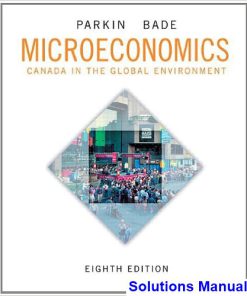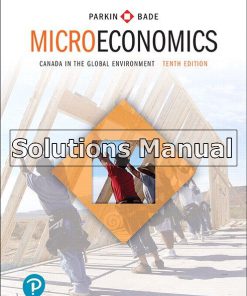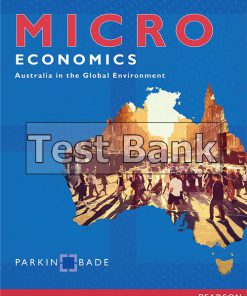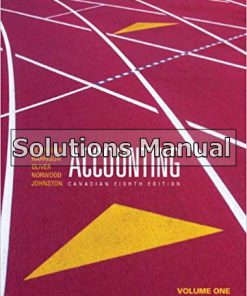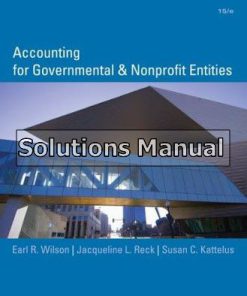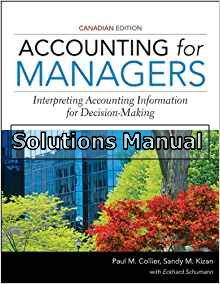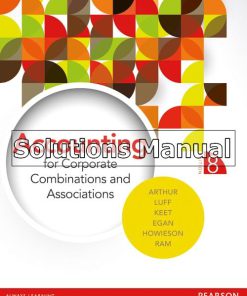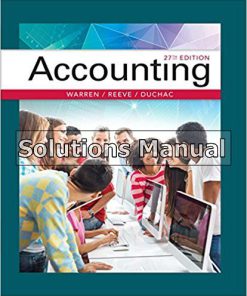Microeconomics Australia in the Global Environment Australian 1st Edition Parkin Solutions Manual
$26.50$50.00 (-47%)
Microeconomics Australia in the Global Environment Australian 1st Edition Parkin Solutions Manual.
You may also like
Microeconomics Australia in the Global Environment Australian 1st Edition Parkin Solutions Manual
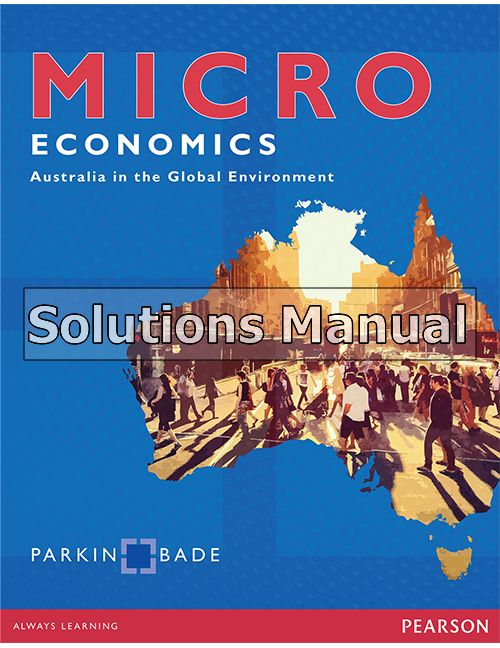
Product details:
- ISBN-10 : 1486019625
- ISBN-13 : 978-1486019625
- Author: Robin Bade
A practice-oriented learning system with a global perspective.
To help students focus on the most important concepts―and effectively practice the application of those concepts―Microeconomics is structured around a system of checkpoints which teach students how to think like an economist. Eye On boxes throughout each chapter challenge students to apply theory to important issues and problems that shape our global society and individual decisions.
The result is a patient, confidence-building program that prepares students to use economics in their everyday lives, regardless of what their future career will be.
Table contents:
- Part 1 Introduction
- Chapter 1 Getting Started
- Learning Objectives
- 1.1 Definition and Questions
- Scarcity
- Economics Defined
- What, How and For Whom?
- Can the Pursuit of Self-Interest Be in the Social Interest?
- Review 1.1
- 1.2 The Economic Way of Thinking
- Economic Ideas
- A Choice Is a Tradeoff
- Cost: What You Must Give Up
- Benefit: What You Gain
- Rational Choice
- How Much? Choosing at the Margin
- Choices Respond to Incentives
- Economics as Social Science
- Economics as Policy Tool
- Review 1.2
- Chapter Summary
- Chapter Review
- Appendix: Making and Using Graphs
- Basic Idea
- Interpreting Data Graphs
- Interpreting Graphs Used in Economic Models
- The Slope of a Relationship
- Relationships Among More Than Two Variables
- Appendix Review
- Eye on the Past: Adam Smith and the Birth of Economics as a Social Science
- Eye on the Benefit and Cost of University: Did You Make the Right Decision?
- Chapter 2 The Australian and Global Economies
- Learning Objectives
- 2.1 What, How and For Whom?
- What Do We Produce?
- How Do We Produce?
- For Whom Do We Produce?
- Review 2.1
- 2.2 The Global Economy
- The People
- The Economies
- What in the Global Economy?
- How in the Global Economy?
- For Whom in the Global Economy?
- Review 2.2
- 2.3 The Circular Flows
- Households and Firms
- Markets
- Real Flows and Money Flows
- Governments
- Governments in the Circular Flow
- Circular Flows in the Global Economy
- Review 2.3
- Chapter Summary
- Chapter Review
- Eye on the Australian Economy: What We Produce
- Eye on the Past Changes in What We Produce
- Eye on the Australian Economy Changes in How We Produce in the Information Economy
- Eye on the Dreamliner Who Makes the Dreamliner?
- Eye on the Global Economy Differences in How We Produce
- Eye on Your Life The Australian and Global Economies in Your Life
- Eye on the Past The Fluctuating Size of Government
- Eye on the Global Economy The Ups and Downs in International Trade
- Chapter 3 The Economic Problem
- Learning Objectives
- 3.1 Production Possibilities
- Production Possibilities Frontier
- Review 3.1
- 3.2 Opportunity Cost
- The Opportunity Cost of a Mobile Phone
- Opportunity Cost and the Slope of the PPF
- Opportunity Cost Is a Ratio
- Increasing Opportunity Costs Are Everywhere
- Your Increasing Opportunity Cost
- Review 3.2
- 3.3 Economic Growth
- Review 3.3
- 3.4 Specialisation and Trade
- Absolute Advantage and Comparative Advantage
- Comparative Advantage: An Example
- Achieving Gains from Trade
- Review 3.4
- Chapter Summary
- Chapter Review
- Eye on Your Life Your Production Possibilities Frontier
- Eye on the Environment Is Wind Power Free?
- Eye on the Global Economy Expanding Production Possibilities
- Eye on the Global Economy Hong Kong’s Rapid Economic Growth
- Eye on the Global Economy No One Knows How to Make a Pencil
- Eye on Your Life Your Comparative Advantage
- Eye on the News Food Production Possibilities and Opportunity Cost
- Chapter 4 Demand and Supply
- Learning Objectives
- Competitive Markets
- 4.1 Demand
- The Law of Demand
- Demand Schedule and Demand Curve
- Individual Demand and Market Demand
- Changes in Demand
- Change in Quantity Demanded Versus Change in Demand
- Review 4.1
- 4.2 Supply
- The Law of Supply
- Supply Schedule and Supply Curve
- Individual Supply and Market Supply
- Changes in Supply
- Change in Quantity Supplied Versus Change in Supply
- Review 4.2
- 4.3 Market Equilibrium
- Price: A Market’s Automatic Regulator
- Predicting Price Changes: Three Questions
- Effects of Changes in Demand
- Effects of Changes in Supply
- Effects of Changes in Both Demand and Supply
- Review 4.3
- Chapter Summary
- Chapter Review
- Mathematical Note
- Eye on Your Life Understanding and Using Demand and Supply
- Eye on the Global Economy The Markets for Cocoa and Chocolate
- Eye on the Price of Coffee Why Did the Price of Coffee Fall?
- Eye on the News Demand and Supply: The Price of Iron Ore
- Part 2 A Closer Look at Markets
- Chapter 5 Elasticities of Demand and Supply
- Learning Objectives
- 5.1 The Price Elasticity of Demand
- Percentage Change in Price
- Percentage Change in Quantity Demanded
- Comparing the Percentage Changes in Price and Quantity
- Elastic and Inelastic Demand
- Influences on the Price Elasticity of Demand
- Computing the Price Elasticity of Demand
- Interpreting the Price Elasticity of Demand Number
- Elasticity Along a Linear Demand Curve
- Total Revenue and the Price Elasticity of Demand
- Applications of the Price Elasticity of Demand
- Review 5.1
- 5.2 The Price Elasticity of Supply
- Elastic and Inelastic Supply
- Influences on the Price Elasticity of Supply
- Computing the Price Elasticity of Supply
- Review 5.2
- 5.3 Cross Elasticity and Income Elasticity
- Cross Elasticity of Demand
- Income Elasticity of Demand
- Review 5.3
- Chapter Summary
- Chapter Review
- Eye on the Global Economy Price Elasticities of Demand
- Eye on the Price of Petrol What Do You Do When the Price of Petrol Rises?
- Eye on Your Life Your Price Elasticities of Demand
- Eye on the News The Elasticity of Demand for Coffee
- Chapter 6 Efficiency and Fairness of Markets
- Learning Objectives
- 6.1 Allocation Methods and Efficiency
- Resource Allocation Methods
- Using Resources Efficiently
- Review 6.1
- 6.2 Value, Price and Consumer Surplus
- Demand and Marginal Benefit
- Consumer Surplus
- Review 6.2
- 6.3 Cost, Price and Producer Surplus
- Supply and Marginal Cost
- Producer Surplus
- Review 6.3
- 6.4 Are Markets Efficient?
- Marginal Benefit Equals Marginal Cost
- Total Surplus Is Maximised
- The Invisible Hand
- Market Failure
- Sources of Market Failure
- Alternatives to the Market
- Review 6.4
- 6.5 Are Markets Fair?
- It’s Not Fair If the Rules Aren’t Fair
- It’s Not Fair If the Result Isn’t Fair
- Compromise
- Review 6.5
- Chapter Summary
- Chapter Review
- Eye on the Australian Economy The Invisible Hand and e-Commerce
- Eye on Price Gouging Should Price Gouging Be Illegal?
- Eye on Your Life Allocation Methods, Efficiency and Fairness
- Eye on the News Making Traffic Flow Efficiently
- Part 3 How Governments Influence the Economy
- Chapter 7 Government Actions in Markets
- Learning Objectives
- 7.1 Price Ceilings
- A Rent Ceiling
- Are Rent Ceilings Efficient?
- Are Rent Ceilings Fair?
- Why Do Some Places Have Rent Ceilings?
- Review 7.1
- 7.2 Price Floors
- A Minimum Wage
- Is a Minimum Wage Efficient?
- Is a Minimum Wage Fair?
- If a Minimum Wage Is So Bad, Why Do We Have It?
- Review 7.2
- 7.3 Price Supports in Agriculture
- How Governments Intervene in Markets for Farm Products
- Price Support: An Illustration
- Review 7.3
- Chapter Summary
- Chapter Review
- Eye on the Australian Economy Fair Work and Award Wages
- Eye on Price Regulation Can Parliament Repeal the Laws of Supply and Demand?
- Eye on Your Life Price Ceilings and Price Floors
- Eye on the News Penalty Rate as Above-Equilibrium Minimum Wage
- Chapter 8 Taxes
- Learning Objectives
- 8.1 Taxes on Buyers and Sellers
- Tax Incidence
- Taxes and Efficiency
- Incidence, Inefficiency and Elasticity
- Incidence, Inefficiency and the Elasticity of Demand
- Incidence, Inefficiency and the Elasticity of Supply
- Review 8.1
- 8.2 Income Tax and Payroll Taxes
- Individual Income Tax
- The Effects of the Income Tax
- A Payroll Tax
- Review 8.2
- 8.3 Fairness and the Big Tradeoff
- The Benefits Principle
- The Ability-to-Pay Principle
- The Big Tradeoff
- Review 8.3
- Chapter Summary
- Chapter Review
- Eye on the Australian Economy Taxes in Australia Today
- Eye on Parliament Does Parliament Decide Who Pays the Taxes?
- Eye on the Past The Origins and History of Australian Income Tax
- Eye on Your Life Tax Freedom Day
- Eye on the News Paying GST on Online Overseas Shopping
- Eye on the Australian Economy How Progressive Are Our Taxes?
- Chapter 9 Global Markets in Action
- Learning Objectives
- 9.1 How Global Markets Work
- International Trade Today
- What Drives International Trade?
- Why Australia Imports Cars
- Why Australia Exports Coal
- Review 9.1
- 9.2 Winners, Losers and Net Gains from Trade
- Gains and Losses from Imports
- Gains and Losses from Exports
- Review 9.2
- 9.3 International Trade Restrictions
- Tariffs
- Import Quotas
- Other Import Barriers
- Export Subsidies
- Review 9.3
- 9.4 The Case Against Protection
- Three Traditional Arguments for Protection
- Four Newer Arguments for Protection
- Why Is International Trade Restricted?
- Review 9.4
- Chapter Summary
- Chapter Review
- Eye on the Australian Economy Australian Exports and Imports
- Eye on Globalisation Who Wins and Who Loses from Globalisation?
- Eye on the Past The History of Australian Tariffs
- Eye on Your Life International Trade
- Eye on the News The Benefits of Free Trade
- Part 4 Market Failure and Public Policy
- Chapter 10 Externalities
- Learning Objectives
- Externalities in our Daily Lives
- Negative Production Externalities
- Positive Production Externalities
- Negative Consumption Externalities
- Positive Consumption Externalities
- 10.1 Negative Externalities: Pollution
- Private Costs and Social Costs
- Production and Pollution: How Much?
- Establish Property Rights
- Mandate Clean Technology
- Tax or Cap and Price Pollution
- Review 10.1
- 10.2 Positive Externalities: Education
- Private Benefits and Social Benefits
- Government Actions in the Face of External Benefits
- Review 10.2
- Chapter Summary
- Chapter Review
- Eye on Your Life Externalities in Your Life
- Eye on the Australian Economy Australian Air Pollution Trends
- Eye on Climate Change How Can We Limit Climate Change?
- Eye on the News The Carbon Reduction Debate
- Chapter 11 Public Goods and Common Resources
- Learning Objectives
- 11.1 Classifying Goods and Resources
- Excludable
- Rival
- A Fourfold Classification
- Review 11.1
- 11.2 Public Goods and the Free-Rider Problem
- The Free-Rider Problem
- The Marginal Benefit from a Public Good
- The Marginal Cost of a Public Good
- The Efficient Quantity of a Public Good
- Private Provision: Underproduction
- Public Provision: Efficient Production
- Obstacles to Efficient Public Provision
- Review 11.2
- 11.3 Common Resources
- Unsustainable Use of a Common Resource
- Inefficient Use of a Common Resource
- Efficient Use of a Common Resource
- Review 11.3
- Chapter Summary
- Chapter Review
- Eye on the Past Is a Lighthouse a Public Good?
- Eye on the Australian Economy Avoiding Free-Rider Problems
- Eye on Infrastructure Should Australia Build More Motorways?
- Eye on Your Life A Student’s Free-Rider Problem
- Eye on the Past The Commons of England’s Middle Ages
- Eye on the Global Economy The North Atlantic Cod Tragedy of the Commons
- Eye on the Global Economy Individual Transferable Quotas Work
- Eye on the News Road or Rail?
- Part 5 A Closer Look at Decision Makers
- Chapter 12 Consumer Choice and Demand
- Learning Objectives
- 12.1 Consumption Possibilities
- The Budget Line
- A Change in the Budget
- Changes in Prices
- Prices and the Slope of the Budget Line
- Review 12.1
- 12.2 Preferences and Choice
- An Indifference Curve
- Degree of Substitutability
- Marginal Rate of Substitution
- Consumer Equilibrium
- Review 12.2
- 12.3 Predicting Consumer Choices
- A Change in Price
- Deriving the Demand Curve
- A Change in Income
- Substitution Effect and Income Effect
- Review 12.3
- Chapter Summary
- Chapter Review
- Eye on the Australian Economy Relative Prices on the Move
- Eye on Your Life Do You Make Your Best Affordable Choices?
- Eye on Song Downloads How Much Would You Pay for a Song?
- Eye on the News Paper Books versus e-Books
- Chapter 13 Production and Cost
- Learning Objectives
- 13.1 Economic Cost and Profit
- The Firm’s Goal
- Accounting Cost and Profit
- Opportunity Cost
- Economic Profit
- Review 13.1
- Short Run and Long Run
- 13.2 Short-Run Production
- Total Product
- Marginal Product
- Average Product
- Review 13.2
- 13.3 Short-Run Cost
- Total Cost
- Marginal Cost
- Average Cost
- Why the Average Total Cost Curve is U-Shaped
- Cost Curves and Product Curves
- Shifts in the Cost Curves
- Review 13.3
- 13.4 Long-Run Cost
- Plant Size and Cost
- The Long-Run Average Cost Curve
- Review 13.4
- Chapter Summary
- Chapter Review
- Eye on Your Life Your Average and Marginal Marks
- Eye on Retailers’ Costs Which Shop Has the Lower Costs: Coles or 7-Eleven?
- Eye on the News Expanding Capacity at The Coffee Club
- Part 6 Prices, Profits and Industry Performance
- Chapter 14 Perfect Competition
- Learning Objectives
- Market Types
- Perfect Competition
- Other Market Types
- 14.1 A Firm’s Profit-Maximising Choices
- Price Taker
- Revenue Concepts
- Profit-Maximising Output
- Marginal Analysis and the Supply Decision
- Temporary Shutdown Decision
- The Firm’s Short-Run Supply Curve
- Review 14.1
- 14.2 Output, Price and Profit in the Short Run
- Market Supply in the Short Run
- Short-Run Equilibrium in Normal Times
- Short-Run Equilibrium in Good Times
- Short-Run Equilibrium in Bad Times
- Review 14.2
- 14.3 Output, Price and Profit in the Long Run
- Entry and Exit
- The Effects of Exit
- Change in Demand
- Technological Change
- Is Perfect Competition Efficient?
- Is Perfect Competition Fair?
- Review 14.3
- Chapter Summary
- Chapter Review
- Eye on Record Shops Where Have All the Record Shops Gone?
- Eye on Your Life The Perfect Competition That You Encounter
- Eye on the News Perfect Competition in Smartphone Apps
- Chapter 15 Monopoly
- Learning Objectives
- 15.1 Monopoly and How It Arises
- How Monopoly Arises
- Monopoly Price-Setting Strategies
- Review 15.1
- 15.2 Single-Price Monopoly
- Price and Marginal Revenue
- Marginal Revenue and Elasticity
- Output and Price Decision
- Review 15.2
- 15.3 Monopoly and Competition Compared
- Output and Price
- Is Monopoly Efficient?
- Is Monopoly Fair?
- Rent Seeking
- Review 15.3
- 15.4 Price Discrimination
- Price Discrimination and Consumer Surplus
- Profiting by Price Discriminating
- Perfect Price Discrimination
- Price Discrimination and Efficiency
- Review 15.4
- 15.5 Monopoly Regulation
- Efficient Regulation of a Natural Monopoly
- Second-Best Regulation of a Natural Monopoly
- Review 15.5
- Chapter Summary
- Chapter Review
- Eye on the Australian Economy Airline Price Discrimination
- Eye on Microsoft Are Microsoft’s Prices Too High?
- Eye on Your Life Monopoly in Your Everyday Life
- Eye on the News Is Google Misusing Monopoly Power?
- Chapter 16 Monopolistic Competition
- Learning Objectives
- 16.1 What is Monopolistic Competition?
- Large Number of Firms
- Product Differentiation
- Competing on Quality, Price and Marketing
- Entry and Exit
- Identifying Monopolistic Competition
- Review 16.1
- 16.2 Output and Price Decisions
- The Firm’s Profit-Maximising Decision
- Profit Maximising Might Be Loss Minimising
- Long Run: Zero Economic Profit
- Monopolistic Competition and Perfect Competition
- Is Monopolistic Competition Efficient?
- Review 16.2
- 16.3 Product Development and Marketing
- Product Development
- Marketing
- Using Advertising to Signal Quality
- Brand Names
- Efficiency of Advertising and Brand Names
- Review 16.3
- Chapter Summary
- Chapter Review
- Eye on the Australian Economy Examples of Monopolistic Competition
- Eye on Mobile Phones Which Mobile Phone?
- Eye on Your Life Some Selling Costs You Pay
- Eye on the News Product Differentiation in Tennis Racquets
- Chapter 17 Oligopoly
- Learning Objectives
- 17.1 What is Oligopoly?
- Small Number of Firms
- Barriers to Entry
- Identifying Oligopoly
- Review 17.1
- 17.2 The Oligopolists’ Dilemma
- Monopoly Outcome
- Perfect Competition Outcome
- Other Possible Cartel Breakdowns
- The Oligopoly Cartel Dilemma
- Review 17.2
- 17.3 Game Theory
- What Is a Game?
- The Prisoners’ Dilemma
- The Duopolists’ Dilemma
- The Payoff Matrix
- Advertising and Research Games in Oligopoly
- Repeated Games
- Is Oligopoly Efficient?
- Review 17.3
- 17.4 Trade Practices Law
- Collusion
- Misuse of Market Power
- Vertical Restraints
- Mergers
- Consumer Protection
- Social Interest or Special Interest?
- Review 17.4
- Chapter Summary
- Chapter Review
- Eye on the Australian Economy Examples of Oligopoly
- Eye on the Global Economy The OPEC Global Oil Cartel
- Eye on Your Life A Game You Might Play
- Eye on the Mobile Phone Oligopoly Is Two Too Few?
- Eye on the News Oligopoly Games in Mobile Phone Service
- Part 7 Incomes and Inequality
- Chapter 18 Markets for Factors of Production
- Learning Objectives
- The Anatomy of Factor Markets
- 18.1 The Demand for a Factor of Production
- Value of Marginal Product
- A Firm’s Demand for Labour
- A Firm’s Demand for Labour Curve
- Changes in the Demand for Labour
- Review 18.1
- 18.2 Labour Markets
- The Supply of Labour
- Influences on the Supply of Labour
- Competitive Labour Market Equilibrium
- Trade Unions
- Review 18.2
- 18.3 Capital, Land and Natural Resource Markets
- Capital Markets
- Land Markets
- Nonrenewable Natural Resource Markets
- Review 18.3
- Chapter Summary
- Chapter Review
- Eye on Tom Scully Why Is Tom Scully Worth $6 Million?
- Eye on Your Life Career Choice and Income Prospects
- Eye on the Global Economy Oil and Metal Prices
- Eye on the News Are Penalty Rates Too High?
- Chapter 19 Economic Inequality
- Learning Objectives
- 19.1 Measuring Economic Inequality
- Income Lorenz Curve
- The Distribution of Wealth
- Wealth or Income?
- Trend in Inequality
- Inequality in Other Countries
- Global Inequality
- Global Trends
- Review 19.1
- 19.2 How Economic Inequality Arises
- Skill Differences
- Contest Winners and Losers
- Differences in Entrepreneurial Ability
- Discrimination
- Stage in Life Cycle
- Inheritance and Assortitative Mating
- Personal and Family Characteristics
- Review 19.2
- 19.3 Income Redistribution
- Cash Benefits
- Income Taxes
- Benefits in Kind
- Indirect Taxes
- The Scale of Income Redistribution
- Why We Redistribute Income
- The Major Redistribution Challenge
- Review 19.3
- Chapter Summary
- Chapter Review
- Eye on Inequality Who Are the Rich and the Poor?
- Eye on the Global Economy Global Inequality
- Eye on the Australian Economy Does Education Pay?
- Eye on Your Life What You Pay and Gain Through Redistribution
- Eye on the News CEOs as Contest Winners
- Glossary
- Index
People also search:
microeconomics 1
microeconomics exam 1 study guide
microeconomics 1.1
ap microeconomics unit 1 study guide
ap microeconomics 1.2


